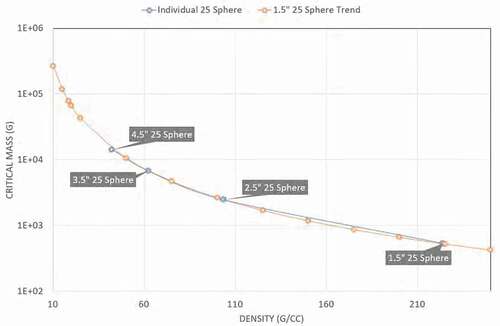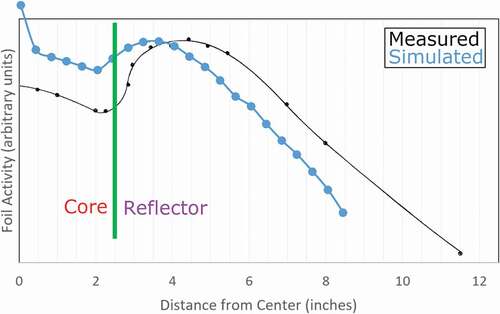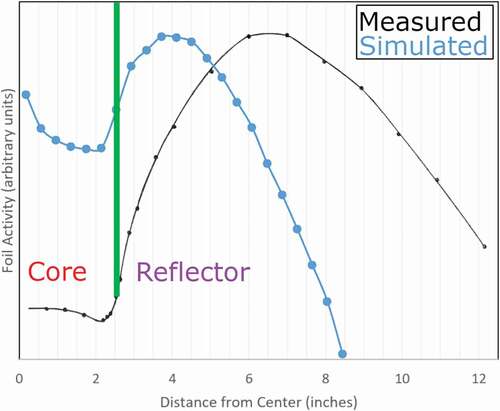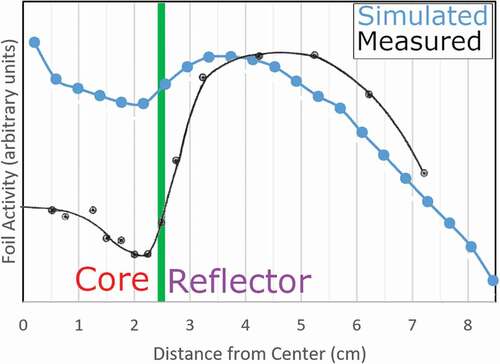 ?Mathematical formulae have been encoded as MathML and are displayed in this HTML version using MathJax in order to improve their display. Uncheck the box to turn MathJax off. This feature requires Javascript. Click on a formula to zoom.
?Mathematical formulae have been encoded as MathML and are displayed in this HTML version using MathJax in order to improve their display. Uncheck the box to turn MathJax off. This feature requires Javascript. Click on a formula to zoom.Abstract
Criticality experiments with 235U (metal and hydride) and 239Pu (metal) were performed during the Manhattan Project. Results from these experiments provided necessary information for the success of the Manhattan Project [LA-1033 to LA-1036 (1947), LA-02532-MS V I (1961), and Critical Assembly: A Technical History of Los Alamos During the Oppenheimer Years, 1943–1945 (1993)]. These experiments have been previously described in compilations made after the Manhattan Project, but those works are either lacking in technical details or are not publicly available. This work aims to provide detailed information while showcasing the enduring impact of these experiments 75 years after they were performed. Furthermore, we use modern computational methods embodied in the MCNP6® code and ENDF data to analyze and interpret these historic measurements. The world’s first four criticality accidents are also discussed, as lessons learned from these helped shape the field of criticality experiments.
I. INTRODUCTION
When the Los Alamos laboratory was formed in April 1943, Fermi had already achieved a critical configuration in CP-1 (CitationRef. 1), but many questions remained related to criticality. As stated by Robert Serber in the Los Alamos Primer,Citation2
[T]hese values of critical masses are still quite uncertain, particularly those for 49.Footnotea To improve our estimates requires a better knowledge of the properties of bomb materials and tamper: neutron multiplication number, elastic and inelastic cross sections, overall experiments on tamper materials. Finally, however, when materials are available, the critical masses will have to be determined by actual test.
These types of measurements were then performed during 1944 and 1945, as described in this paper and in our companion paper on the Water Boiler and Dragon.Citation3 The results of these criticality experiments were so important that Oppenheimer stated to “notify him at once if any serious change in the estimated critical mass should be indicated by the experiments.”Citation4 The focus of this work is on two specific experiments: one using metal 235U and 239Pu in spherical geometry and one utilizing cubes of 235U in hydride form. The 235U was enriched at Y-12 at the Oak Ridge National Laboratory and the 239Pu was provided by reactors at Hanford. This material did not start arriving until late 1944 and experiments were performed as new material kept arriving in Los Alamos. Many of these experiments were subcritical, as there was not enough material available yet to obtain criticality. Both experiments included bare (no reflector) measurements as well as measurements with various reflectors. All of the bare experiments, however, were subcritical and no bare critical assemblies were constructed until 1951 for 25 (Lady Godiva which used ~94 wt% 25) (CitationRefs. 5 and Citation6), and 1954 for 49 (Jezebel which used ~94 wt% 49) (CitationRefs. 7 and Citation8). These experiments helped answer key questions necessary for the Manhattan Project to be successful.
This paper includes information on the background and theory associated with criticality experiments, early nuclear data experiments, and a description of the metal and hydride criticality experiments. Information on early criticality accidents is also presented. Lessons learned from these accidents are as important as the experiments themselves, since they resulted in the establishment of a critical experiment capability. Last, the continued impact of these experiments and accidents is discussed. References in this work include many source documents that may not be easily accessible by the public.
II. BACKGROUND AND THEORY
During the Manhattan Project, multiplication was defined as
| = | = number of fissions produced by | |
| v | = | = number of neutrons produced per fission |
| = | = ratio of capture to fission.Citation9,Citation10 |
Note that today this is often referred to as “total multiplication” and relates to the effective multiplication factor via
Fermi established the approach-to-critical method used at CP-1. As they were building CP-1, Fermi and others were taking measurements of the neutron density in the center of the pile with indium foils. The activity of these foils was measured and recorded as a function of the number of natural uranium layers as they were building CP-1. The inverse of the geometry-corrected activity of the indium foils was plotted as a function of natural uranium layers. The plot clearly predicted the layer (amount of natural uranium) at which CP-1 was going to go critical.Citation1 A similar method is used to this day for assembling fissile material, such as the experiments performed at the National Criticality Experiments Research Center (NCERC) in Nevada.Citation11 For this method, relative multiplication is approximated by measuring count rates of two systems, often using external detectors, via
| C | = | = detector count rate |
| S | = | = source emission rate |
| Ω | = | = detector solid angle |
| = | = detector intrinsic efficiency. |
Here the 0 subscript refers to an initial configuration, and the multiplication is relative to the initial configuration as shown in EquationEq. (3)(3)
(3) . This initial configuration may be a system with no material (other than a source), which will have
. Ideally, for properly designed experiments, the following terms will not change as the configuration changes (through addition of fuel or reflector material, for example):
,
, and
. If these terms are constant, and it is assumed that
, then EquationEq. (3)
(3)
(3) reduces to
Once the critical mass was determined, it was often convenient to estimate the equivalent mass for different densities and enrichments. During the Manhattan Project, the following empirical estimates were givenCitation12,Citation13:
The two experiments described in this work occurred in 1944 and 1945 and evolved as more material was made available. These experiments took place after the Water BoilerCitation3 had started up (since that experiment required less nuclear material). These experiments utilized much of the same equipment and personnel as the Water Boiler experiments.
A large amount of coordination was needed to achieve these criticality experiments. Due to the importance and the complexity of this coordination, Oppenheimer and the technical board generally advised on the prioritization and scheduling of these experiments (which took place during meetings in Oppenheimer’s office, often at night).Footnoteb Coordination was required in regard to receipt of material from various sites, metallurgy, design of experiments, execution of experiments, measurement equipment, and theoretical calculations (in addition to other considerations). Often a prioritized list of experiments was established, and sometimes not all the experiments were performed, as other uses of the same nuclear material were deemed to be of higher priority.
III. NUCLEAR DATA
At the start of the Manhattan Project, the collective knowledge of nuclear data was limited. As an example, the number of neutrons produced per fission ν was unknown for fission in 49 and for fast fission in 25 (CitationRefs. 5, Citation16, and Citation17). It was understood from the beginning of the Manhattan Project that knowledge of the properties of fission and radiation interaction in matter was required for success. These measurements started in 1943 and were often compared to hand calculations. Many of the measurements were compared to measurements taking place at other laboratories, such as the Metallurgical Laboratory in Chicago. The majority of these measurements were conducted with small quantities of material (often milligram samples), and the estimates would be refined based on the material used and the techniques used for data analysis. It was very important to have repeatable measurements as the nuclear data were so uncertain and new at that time.
The number of neutrons produced per fission was of extreme importance (and remains important to this day) as it will affect criticality more than any other nuclear data parameter. Many measurements of
were performed during the Manhattan Project. A subset of these include measurements of 23 (CitationRef. 18), 25 (CitationRef. 19), 40 spontaneous fission,Citation20 and 49 (CitationRefs. 18, Citation19, Citation21, and Citation22). Often 25 was (and still is) used as a standard for relative comparisons. shows various measurements of
performed during the Manhattan ProjectCitation21–27 and compares them against ENDF/B-VIII.0 (CitationRef. 28), the latest U.S. nuclear data library release. It can be seen that the last four data points in are in good agreement with the current ENDF/B-VIII.0 data.
Fig. 1. Ratio of the number of neutrons emitted from fission v in 49 to 25. Data points were all measured during the Manhattan Project. The shaded region is 1.19 to 1.20, the ratio from ENDF/B-VIII.0 (CitationRef. 28) (assuming 1- to 2-MeV incident neutron energy)
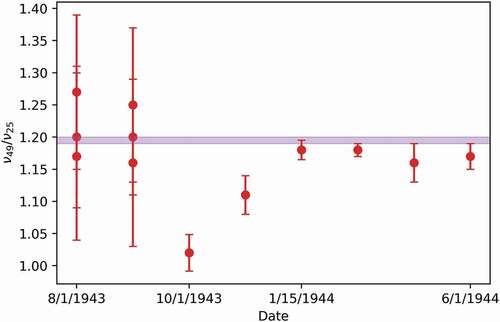
Fission cross sections were (and still are) also of great importance. During the Manhattan Project, the personnel knew of resonances and were able to estimate some of them.Citation19 It was known that some resonances could not be resolved at that time.Citation29 The majority of the fission cross-section measurements were on induced fission in 25 (CitationRefs. 9, Citation19, Citation20, Citation27, Citation30, Citation31, Citation33, Citation36, and Citation37 through Citation38). In addition, measurements were performed for 23 (Refs. Citation18 and Citation20), 28 (Refs. Citation9, Citation19, Citation31, Citation35, and Citation39), 37 (CitationRefs. 31 and Citation39), and Citation49 (Refs. Citation27, Citation30, and Citation31) fission. 25 was again used as a standard, and the ratio of induced fission in 49 to 25 was often reported.Citation19,Citation22,Citation40
Other reaction cross sections investigated included capture and scattering. Capture was investigated for many elements, including goldCitation24,Citation38, Citation41–43 (which is a standard to this day), 25, and 28 (Refs. Citation32, Citation44, and Citation45). One parameter often reported is α, which is the ratio of capture to fission. This was measured for 25 (CitationRef. 46) and 49 (CitationRef. 27). Similarly, scattering was measured for 25 (Refs. Citation32, Citation47, and Citation48) and 28 (CitationRef. 49), among other nuclides and elements.
Before material was available to investigate criticality, semi-integral measurements were already estimating the effectiveness of different reflector materials.Citation35 These experiments were generally transmission measurements that compared a detector response to a neutron source with and without the material being investigated. The materials that were the most effective at reflecting neutrons were studied often (theory was developed to understand this effectiveness).Citation50 These included Tuballoy (Tu, natural uranium),Citation32,Citation38,Citation42,Citation51–53 beryllium (Be) (CitationRef. 54), tungsten (W) (Refs. Citation32, Citation34, Citation42, Citation51, Citation52, and Citation53), tantalum (Ta) (Refs. Citation32, Citation42, Citation51, and Citation53), and lead (Pb) (Refs. Citation32, Citation34, Citation42, Citation51, Citation52, and Citation53). Many of these measurements were types of transmission measurements, which are commonly performed to this day.
Spontaneous fission measurements, led by Emilio Segrè, were also performed throughout the Manhattan Project. The most notable measurements were of 40, which confirmed suspicions by Seaborg, Fermi, and others that 40 spontaneous fission was very highCitation55,Citation17,Citation56; this also supported results of spontaneous fission previously conducted by Frederic Joliot.Citation55 The results of Segrè were the main driver for the reorganization of Los Alamos in 1944 (Refs. Citation55, Citation17, and Citation56). In addition to the 40 measurements, additional measurements were performed on 25 (Refs. Citation30 and Citation57), 28 (Refs. Citation38 and Citation57), 48 (CitationRef. 20), and 49 (Refs. Citation34, Citation35, and Citation42). Comparison between 49 produced in Berkeley (likely 99+% 49) and Clinton Engineer Works (which would have higher 40 content) is what led to the initial suspicion that 40 spontaneous fission may be very high.Citation34,Citation35 One important note is that these were precision measurements, as any measurements on nuclides that have low spontaneous fission emission require both very long count times and very low, well-characterized background. Additional information on nuclear data from the Manhattan Project is given in a different work in this same issue.Citation14
IV. 25 AND 49 METAL SPHERICAL EXPERIMENTS
Measurements were performed to estimate the multiplication of 25 and 49 metal spheres. The 25 was in the form of -stage (72% to 81% enrichment 25) (CitationRef. 12) material. These measurements continuously took place from late 1944 until mid-1945 and were performed by the R division (led by Robert Wilson).
As additional metal was made available, new measurements were performed, as shown in . These parts were referred to by their outer diameter (OD), which is also retained here. The initial 25 material had a 0.314-in. inner diameter (ID) and 1.5-in. OD, which had a mass of 525 g. As seen in , more material was used up to an OD of 4.5 in., which had a corresponding mass of 14 to 15 kg (not reported, but calculated using reported dimensions and a density of 18.4 g/cmCitation3). A 5.0-in.-OD metal sphere was planned (which would have been the last 25 metal sphere).Citation4 This material was originally scheduled to be available on March 15 to 20, 1945. Due to the 4.5-in.-OD results as well as the urgent overall schedule of the Manhattan Project, it was decided that it was not necessary to make the 5.0-in.-OD sphere.Citation58 Some of these hemispheres nested together as shown in .
TABLE I Material Used in 25 and 49 Metal Sphere Experiments
Fig. 2. Setup of the fission chamber measurements (which inferred system multiplication) for the 25 metal sphere experiment reflected by Tu with the Water Boiler as the neutron source (from CitationRef. 12)
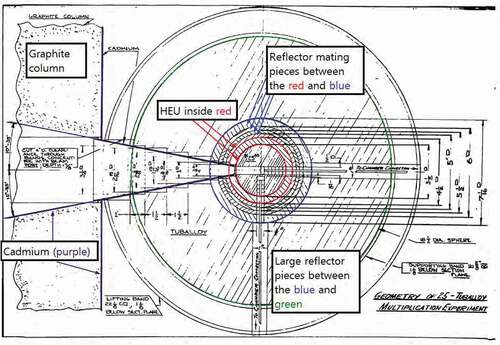
Tuballoy and tungsten carbide (WC) reflection were provided by some experiments. The Tu consisted of two large hemishells with 7.0625-in. ID and 18.125-in. OD (approximately 900 kg); smaller hemishells were used to mate these reflectors to the 3.5- or 4.5-in.-OD 25 spheres as shown in . The WC reflectors were constructed from 2.125 × 2.125 × 4.25-in. blocks. It is assumed that these blocks were arranged to form a pseudo-sphere.
When performing criticality experiments with highly enriched uranium (HEU) and pure 49, it is necessary to have a source of neutrons in order to obtain statistically significant results in reasonable measurement times. Various neutron sources were used for these experiments. Mock fission sources that utilized a mixture of Po (an emitter) with either B (CitationRef. 59), BF3 (CitationRef. 60), NaBF4 (CitationRef. 61), or a mixture of NaBF4 and BeF2 (Refs. 18 and 61) were used.Citation4,Citation9,Citation32,Citation57,Citation62 The mock fission sources improved during the Manhattan Project, and different target materials were chosen to provide a better match of the prompt fission neutron spectrum. Instead of mock fission sources, some experiments utilized the Water Boiler.Citation12,Citation13,Citation57 For these experiments, the Water Boiler was operated up to 4.5 kW (CitationRef. 13) and a graphite column was utilized with a cadmium (Cd) cone to ensure that only direct neutrons (those that have not undergone scattering) from fission in the Water Boiler reached the spheres, as shown in purple in .
The criticality experiments on the metal spheres were measured using multiple means. Several experiments used the long counter,Citation4,Citation9,Citation32,Citation62 which would be external to the spheres. The long counter was designed to have uniform efficiency over a large range of neutron energies and had BF3 inside paraffin.Citation63,Citation64 Other experiments utilized 25 and 28 fission chambersCitation12,Citation57,Citation65 and cellophane foilsCitation13 inside the spheres. Geiger-Müller counters were used to measure fission fragments from the cellophane foils. Generally, the long counter was used for the experiments with the mock fission source, and the fission chambers and foils were utilized for the Water Boiler experiments.
Results from the bare experiments are given in and for the reflected experiments in . The measured results were obtained using EquationEq. (4)(4)
(4) ; since the initial count was generally taken without any material present (just a source), the
given in EquationEq. (4)
(4)
(4) is an estimate of the absolute multiplication. The bare results are compared with theory (from the same references), but no theoretical results were provided for the reflected configurations. It can be seen in that there was a fairly wide range of results. However, it should be noted that even today, when at low multiplication, the uncertainties are often quite large. The uncertainties shown in only include statistical uncertainties, and it is known that these measurements would have much larger systematic uncertainties, which were not estimated. Given that multiple detection systems and analysis methods were used, the spread in results shown is not surprising. The calculated results were determined using neutron diffusion theory.Citation10,Citation66
Fig. 3. Multiplication (measured and calculated) for the bare 25 sphere experiments. Results are from CitationRefs. 4, Citation9, Citation20, Citation57, Citation62, and Citation65 (all reported during the Manhattan Project)
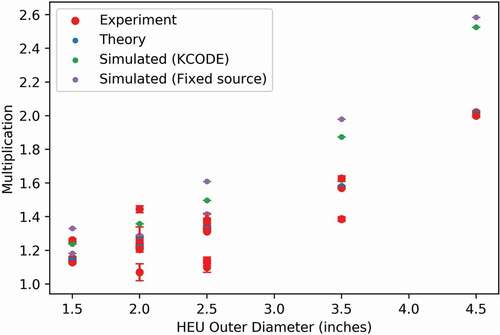
Fig. 4. Multiplication (measured) for the bare and reflected 25 sphere experiments. Results are from CitationRef. 4, Citation12, Citation13, and Citation20 (all reported during the Manhattan Project)

include results using the MCNP6.2Footnotec code with ENDF/B-VIII.0 data. These include both criticality eigenvalue (KCODE) and fixed-source simulation results. It can be seen that the comparison to measurements is not particularly close. That being said, it should be stressed that the documentation on these experiments is not adequate to create a detailed model. So there certainly could be a bias in the models due to this lack of documentation.
Many corrections or extrapolations were applied to the results. These included corrections for the small central cavity (to allow for fission chambers or foils),Citation67 corrections to higher (nominal) densities using EquationEq. (5)(5)
(5) (CitationRef. 12), corrections to higher enrichment using EquationEq. (5)
(5)
(5) (CitationRef. 12), reflector thickness,Citation12 and reflector impurities.Citation68
Ironically, no inferred bare critical mass estimates were given in the references, even though the measurements can be (and were) used to estimate the bare critical mass. Here we will describe how to perform this estimate with the original data. In order to estimate the bare critical mass, the inverse of the multiplication values in were first used to infer a critical mass with the density and enrichment associated with the measured HEU. Then EquationEq. (5)(5)
(5) was used to estimate the critical mass of pure 25 at nominal density (19 g/cmCitation3). Note that no correction was made for the small central hole; this, however, would have a very small effect on the results (especially those that use larger hemishells). It should also be noted that some of the references are inconsistent in regard to the enrichment and density of the 25 spheres; this is particularly important for enrichment, as the critical mass changes about 1 kg per 1% change in enrichment. The exponent values in EquationEq. (5)
(5)
(5) are different from those used “today”: −2 (not −1.4) is used for density correctionCitation69 and −1.71 (not −1.8) was given in the 1950s after more material was available.Citation70 In the end, these differences in corrections do not matter very much, as shown in , which shows the bare 25 critical mass estimates. The critical radius is found using the same data with EquationEq. (6)
(6)
(6) to correct for an ideal sphere of 25 and is shown on the right y-axis.
Fig. 5. Critical mass and radius estimates for bare 25 (100% enrichment). These estimates utilize multiplication results from CitationRefs. 4, Citation9, Citation57, and Citation62. The data on the right side of this graph are most accurate, since the extrapolation is least there, giving a pure 235U bare critical mass of 50.8 ± 2.5 kg
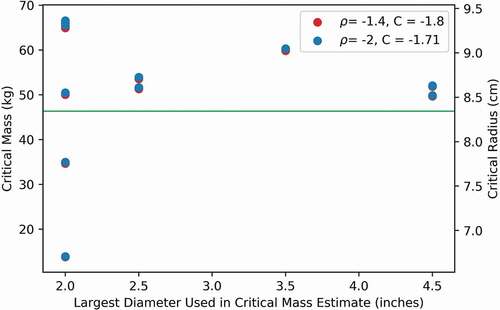
In order to confirm that the density exponent should indeed be −2, a series of MCNP simulations were performed as shown in . First the enrichment information of the 1.5-in.-OD sphere was used, along with a chosen density, and the radius was varied to find a critical mass. In addition, each of the 25 sphere models (1.5-, 2.5-, 3.5-, and 4.5-in. OD) was used (keeping the geometry constant this time), and the density was varied (shown in blue). This resulted in an exponent of −1.979, thus confirming the expected result of −2 (not −1.4).
It can be seen in that the critical mass estimates using these data vary widely. This is not surprising, however, given the spread in the results in multiplication shown in . Since the predicted critical is related to the slope of inverse multiplication, a large spread in multiplication will result in a large spread of critical mass. It is known, however, that as the multiplication increases, the accuracy of the critical prediction improves. For this reason, the results in were plotted as a function of the largest hemishells used for the critical mass estimate. So the points on the right side of the graph are expected to be more accurate (and have less spread) than the points on the left side. It can be seen that this is indeed the case when compared against today’s ENDF/B-VIII.0 result of 46.36 kg.28 Enough information to provide accurate uncertainty estimates is not available (especially in regard to enrichment). Using the two data points on the far right of , we would give a best estimate of the pure 235U bare critical mass from these experiments as 50.8 ± 2.5 kg. These critical mass estimates should also be compared against calculations of 25 critical mass, given in this issue.Citation14
The same approach can also be applied to the Lady Godiva experiment performed at Los Alamos in the 1950s (CitationRef. 5). Unlike the deeply subcritical spherical experiments discussed in this section, Lady Godiva was a bare sphere of HEU that was critical. The Lady Godiva experiment had a mass of 52.42 kg, a density of 18.74 g/cmCitation3, and an enrichment of 93.71 wt% 25 (CitationRef. 71). Using these specifications with Eq. (5), we calculate a critical mass of 45.7 kg [using the exponent values in EquationEq. (5)(5)
(5) ]. Using the newer exponent values (−2 for density and −1.71 for enrichment as described previously), we calculate a similar value of 45.6 kg. Both of these are very close to the ENDF/B-VIII.0 result of 46.36 kg, which should not be surprising since ENDF data typically have been calibrated to accurately match the Lady Godiva results.
The measurements given in were used in CitationRef. 13 to estimate the critical mass for pure 25 reflected by WC and Tu: these estimates were 13.8 and 15.8 kg, respectively. Commonly reported values for theseCitation69 include 16.0 kg for WC and 16.1 kg for Tu. Using the MCNP6.2 code with ENDF/B-VIII.0 gives 14.96 kg for the critical mass of 100% 25 at 19 g/cmCitation3 surrounded by infinite WC at 15 g/cmCitation3, a similar result (Refs. Citation99, Citation100, Citation101, and Citation104).
Due to the high toxicity of 49, it was desirable to reduce the number of refabrications and the number of individual pieces.Citation72 A 49 sphere with a 0.9-in. OD was available around March to April 1945. Information on the fabrication of this 49 is given in a different work in this issue.Citation73 This resulted in a reported multiplication of 1.197 ± 0.004. This measurement is significant as it is the first recorded measurement of multiplication in 49. Prior to this, only small quantities of 49 were available. The exact mass of the sphere is unknown, but it was likely around 100 g. Subsequent Pu experiments were focused on the direct support of Trinity.
The metal experiments were utilized to estimate the quantity . This resulted in 25 values shown in , which also compares them to modern results. Only two results for 49 were given during the Manhattan Project, which were 2.14 ± 0.1614 and 2.02 (CitationRefs. 72 and Citation74); these compare well to a value calculated from modern nuclear data of approximately 2.08 ± 0.10 (CitationRef. 75).
TABLE II Material Used in 25 and 49 Metal Sphere Experiments
V. HYDRIDE ASSEMBLY
Criticality experiments with solid uranium hydride were performed in 1944 to 1945 by group G-1 (led by Otto Frisch underneath division leader Robert Bacher). The use of uranium hydride was logical to the fact that less material would be required due to moderation created by the presence of hydrogen.
The fissile material consisted of UH3 and Styrex (CH1.75) in the form of 0.5- or 1.0-in. cubes. Initially, not enough material was available to be critical with UH10 using a BeO reflector. For this reason, initial experiments had a higher hydrogen content (UH80, then UH40, UH25, and UH15, until it was possible to go critical with UH10). In September 1944, 0.25 kg could be produced in 1 day but by December this increased to 0.5 to 1 kg (CitationRef. 76). The information presented in this section largely comes from a single report, which was not documented until after the Manhattan Project.Citation77 The material was reflected by either BeO, Fe, WC, Pb, or Tu. Bare measurements (without a reflector) were also performed.
There were three types of assemblies used in the hydride experiment. The first was the BeO experiment, shown in , which consisted of BeO bricks stacked on a stationary reflector in a pseudo-sphere. The lower BeO bricks were on a movable platform. The fuel (and part of the BeO reflector) were in a steel tray that was inserted from the side. While other experiments (such as CP-1 and the Water Boiler) preceded this experiment, this is the first assembly that bears resemblance to the critical assembly machines used today. The operating process and safety functions are very similar to those used in today’s vertical lift assemblies (such as the CometCitation78 and PlanetCitation79 assemblies at the NCERC). Some of the BeO experiments did not utilize this assembly and were built by hand with no safety features.
Fig. 7. Hydride experiment assembly for BeO experiments.Citation76
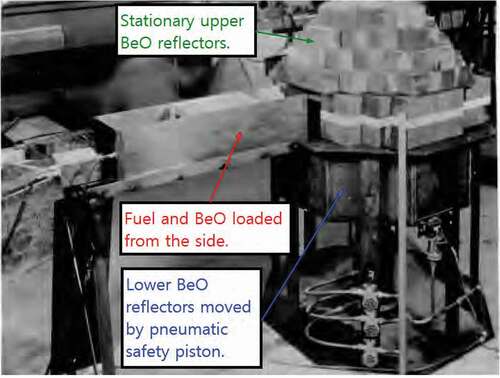
The second type of experiments used spherical Tu, Fe, and Pb reflection (with mating pieces to match the cube geometry). Unlike the BeO experiment, no material was inserted from the side. Here, the lower hemispherical reflector and hydride material were raised pneumatically into the upper hemispherical reflector. The Fe-reflected system is shown in . For the Tu-, Fe-, and Pb-reflected experiment, the system was not critical as a sphere. In order to obtain criticality, additional UH10 cubes (and reflector blocks) were placed in between the two hemispheres, resulting in an elliptical system. When using the Pb reflector, not enough material was available, and criticality was never obtained.
Fig. 8. Hydride experiment assembly for the Fe, Tu, and Pb experiments (Fe reflector shown).Citation76
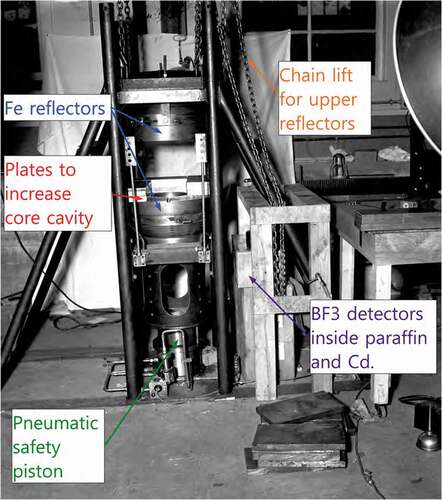
Critical mass estimates were performed using a approach to critical, as shown in . All experiments were operated with personnel present in the room, as these experiments preceded the Daghlian and Slotin criticality accidents, which changed the way that critical experiments are performed.Citation80–82 The experiments that utilized an assembly, however, would scramFootnoted
if the neutron population in the external BF3 detectors (shown in ) exceeded a set threshold. includes comparison to simulations with the MCNP6.2 code using ENDF/B-VII.1 cross sections
TABLE III Hydride Predicted Critical Results
Measurements were performed with Mn, Au, and W foils for the BeO- and WC-reflected experiments. These measurements provide spatial information of the neutron flux. A comparison of the measured and simulated (using the MCNP6.2 code) foil activity is shown in . It can be seen that the Au foil results compare better than the Mn or W results. It is not clear if the poor comparison between measurements and simulations is due to large experiment uncertainties, a measurement bias, or a misunderstanding in the model geometry due to poor documentation. Similar measurements were performed by measuring the UH10 parts themselves with a Geiger-Müller counter after going supercritical and ensuring that significant fissions had occurred to yield accurate statistics. These utilized UH10 with dimensions of 0.125 × 0.5 × 0.5 or 0.25 × 0.5 × 0.5 in.; having smaller components allowed for greater spatial resolution. These experiments were also performed using BeO reflection with Cd in between the core and reflector regions. These results showed the importance of thermal neutron reflection from the BeO, and there was a large amount of thermal fission occurring at the edge of the core.
Rossi- measurements,Citation83,Citation84 which provide the prompt neutron decay constant of the system, were also performed. These are neutron noise measurements that were first used during the Manhattan Project on the Water Boiler, and it was thus a very new measurement method when the hydride experiments were performed. This method utilizes knowledge that multiple neutrons are generally created at the exact same time from a single fission event. This resulted in neutron lifetime estimates of 5.5 and 1.3 µs for the BeO and WC experiments, respectively.
VI. CRITICALITY ACCIDENTS
The section describes the world’s first four criticality accidents, which occurred in Los Alamos in 1945 and 1946. Note that a criticality accident is any condition in which a supercritical state is achieved at a time when it is not intended. It is possible to have criticality accidents in which no personnel nor nuclear material nor equipment are harmed, although some criticality accidents result in loss of life (including some of the accidents described here). In many ways, the accidents described here had as much of an impact as the experiments themselves, as they established how criticality experiments should be safely performed. We still implement lessons learned from these accidents to this day:
Accident 1: The world’s first criticality accident occurred with the DragonCitation3 assembly on February 11, 1945 (CitationRef. 80). Dragon used uranium-hydride cubes, like those described in Sec. V. A typical Dragon burst had a yield on the order of fissions. This could be modified by changing the starting neutron rate prior to the burst. If consecutive bursts were performed, the yield would continue to get larger. During the final burst,
fissions were produced. This resulted in the uranium-hydride cubes rising in temperature so much that blistering and swelling occurred. The system expanded by about 1/8 of an inch.Citation80,Citation85 Given that no personnel were injured, and that the term “criticality accident” did not exist then, this was not considered a criticality accident at the time. The original report on Dragon does describe this final burst in detail, but does not refer to it as a criticality accident.Citation85 It is noted that this incident does not necessarily meet the definition of a criticality accident given that the experimenters did intend to exceed superprompt critical. That being said, given that the yield was larger than expected and the fact that there were some noticeable material changes, this is commonly accepted today as a criticality accident and is included in the compilation of criticality accidents.Citation80
Accident 2: The second criticality accident occurred 4 months later on June 6, 1945 (the 1-year anniversary of D Day). Here 35.4 kg of HEU metal (average 79.2% 25) was built in a pseudosphere.Citation80,Citation86 This was in a polyethylene box that was put in a tank that was filled with water. The system went supercritical before the tank was fully filled. Subsequent inspection showed that the polyethylene box was not watertight. It was calculated that fissions occurred and the temperature in the metal may have risen by as much as 200°C. There was no scram system, and the configuration became subcritical due to the falling water level and the boiling of the water inside the polyethylene box (in addition to the reactivity loss of thermal expansion). There was nonlethal radiation exposure, and the material was used again for experiments 3 days later.Citation80,Citation86 This event was also not considered to be a criticality accident at the time.
Accident 3: This accident involved a 6.2-kg sphere of -phase Pu (with a density of 15.7 g/cmCitation3) reflected by WC (CitationRef. 80). This can be considered an extension of the sphere measurements described in Sec. IV, which also included WC reflection. On August 21, 1945, Harold Daghlian was assembling this experiment (re-creation shown in ). He was working alone (although there was a guard 12 ft away)Citation86 late at night. He was going to add a WC brick to the assembly, but when he saw from the neutron counters that this would likely result in a supercritical system he withdrew his hand. The brick slipped out of his hand and fell onto the system, resulting in a superprompt critical configuration. He quickly pushed the brick off and unstacked the assembly. This accident resulted in
fissions and a fatal dose of 510 rem (from which Harold Daghlian died 28 days later).Citation80 While this was actually the third criticality accident, it was documented as the first accident at the time.
Fig. 12. Plutonium sphere with WC reflection. This picture was taken as part of documentation related to the criticality accident on August 21, 1945 in which Harold Daghlian was killed (CitationRef. 80)
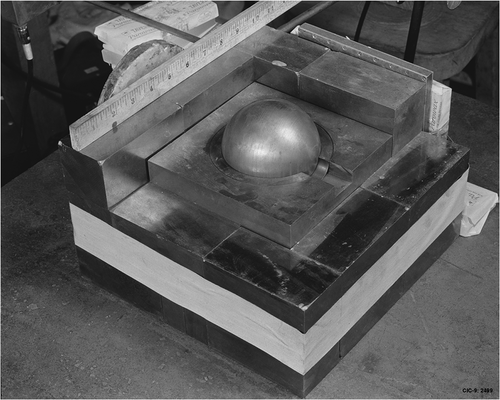
Accident 4: This accident involves the same core of Pu as the Daghlian accident. Louis Slotin (who became group leader of critical assemblies in late 1945) (CitationRef. 87) was performing a demonstration. The configuration included the Pu core reflected by Be. In this accident, half of the upper Be hemisphere was touching the lower hemisphere while the edge 180 deg away was resting on a screwdriver. In this now famous criticality accident (which has been recreated in popular culture, such as the 1989 Fat Man and Little Boy movie), the top hemisphere slipped, and the upper Be hemisphere contacted the lower hemisphere resulting in a supercritical configuration. Slotin quickly removed the upper hemisphere, but fissions had already occurred. Slotin received over 1000 rem and died 9 days later.Citation80,Citation88 Additional information on Louis Slotin is provided in a separate work in this issue that details the Canadian contributions to the Manhattan Project.Citation89 It should be noted that by today’s standards, some might consider these four accidents “sloppy work” or think that the experimenters were not being careful or (worse yet) did not understand what they were doing. One must not, however, think about these isolated incidents without considering the larger context. It should be stressed that during 1945 thousands of troops were dying each day in the war, which resulted in immense time pressure. In addition, these experiments were essentially uncharted territory; these configurations are complex systems with three-dimensional geometries and multiple materials, therefore criticality could not be estimated accurately at that time.
After the Slotin accident, the critical experiment capability was established at the Pajarito Site (later called the Pajarito Laboratory and the Los Alamos Critical Experiments Facility). This established the protocol for conducting remote critical experiments.Citation81,Citation82 Some of the listed requirements include
1. Experiments will be conducted remotely unless it can be made critical only if several accidents, both independent and improbable, occur simultaneously (known today as the “double contingency principle”).
2. The neutron population will be monitored and the speed of the assembly should be limited such that there is time for human response.
3. The critical condition will be predicted from subcritical configurations (approach-to-critical methodology).
4. Each assembly should have two independent safety devices that will disassemble the reactor sufficiently to stop the chain reaction.
5. Experiments will be performed using written operating procedures.
VII. CONCLUSIONS AND CONTINUED IMPACT
The results of two experiments conducted during the Manhattan Project were discussed. The 25 and 49 experiments included the first subcritical experiments ever performed on kilogram quantities of metal nuclear material. They also provided the first multiplication results for bare and reflected 25 metal. The experiments described here helped establish criticality experiment operations. Critical experiments are extremely useful for nuclear data validation to this day; in fact, many of the early Los Alamos experiments from the 1950s (which grew out of these experiments) are some of the primary experiments used for validation of 25 and 49 nuclear data by the ENDF community.Citation75
These two experiments have continued to impact both Radiation Test Object (RTO) and critical assembly operations. The theories developed in conjunction with these experiments are used to this day. The approach-to-critical methodology used in these experiments (and previously at CP-1 and the Water Boiler) are still used today to estimate critical masses.Citation90 Similarly, fission chamber and activation foils are used currently with critical experiments to provide nuclear data validation.Citation91 The Rossi- method is also still used to provide timing information on nuclear material systems.Citation92,Citation93
Radiation Test Objects are configurations assembled primarily for radiation detection testing and validation. The 25 and 49 metal spherical experiments are essentially the first RTOs ever built. Today, hundreds of RTO operations are performed each year at the NCERC (CitationRef. 94). These RTOs also often involve spherical configurations with 25 (CitationRefs. 95, Citation96, and Citation97) and Citation49 (CitationRefs. 98 through Citation102). Modern experiments still have goals to provide measured results for improvements in nuclear data (such as the results in ).
While the hydride work was ultimately stopped due to higher than expected critical masses and slow-neutron lifetime,Citation76 this experiment included the first critical assembly machine that is similar to those used to this day. At the NCERC there are four critical assembly machines that are routinely used for critical experiments, and two of themCitation77,Citation78 are very similar to the hydride assemblies. While the hydride BeO assembly involves lifting reflector materials from the bottom and fuel with reflectors from the side, the current vertical lift machines generally only lift fuel and/or reflectors (and/or moderators) from the bottom (similar to the Tu, Fe, and Pb hydride experiments). The hydride experiments were performed with people in the same room, which would never be done today due to lessons learned from criticality accidents, but they did contain a scram system (similar to those currently used). These experiments were not only important in the development of the Manhattan Project, but have continued impact to this day.
The lessons learned from the four criticality accidents given in Sec. VI resulted in a protocol to perform critical experiments. These lessons learned were incorporated in the ANS-1 (“conduct of critical experiments”) standard.Citation103 The accidents described in this work are used for training of critical assembly operators to this day at facilities such as the NCERC. It should be noted that after the protocol described in Sec. VI was established, only one other experimental criticality accident resulting in fatalities has occurred in the United States (the SL-1 reactor in 1961, which included a steam explosion resulting in three fatalities104). Lessons learned from these early experiments and criticality accidents were also passed on to the metallurgists and chemists. These applied to the handling and fabrication of nuclear material and formed the basis of the field now known as criticality safety. These lessons learned are applied in nuclear facilities across the world.
Acknowledgments
This work was supported by the U.S. Department of Energy (DOE) through the Los Alamos National Laboratory. Los Alamos National Laboratory is operated by Triad National Security, LLC, for the National Nuclear Security Administration of the DOE under contract number 89233218CNA000001.
Thanks to Daniel Alcazar, Alan Carr, and Mark Chadwick for help in finding historical documents and Richard Malenfant for discussions on historical experiments.
Notes
a During the Manhattan Project, a notation in which the last integer of the Z number and A number are combined to refer to a nuclide. For example, 25, 28, and 49 refer to 235U, 238U, and 239Pu, respectively. This notation is retained throughout this work. Pu-240 was called both 40 and 410, but this work will refer to it only as 40.
b See “Minutes of Technical and Scheduling Conference” meeting notes by Samuel Allison from 1944–1945. A complete list of these meeting notes is contained in the following Los Alamos reports: LA-00160-MS, LA-00172-MS, LA-00183-MS, LA-00184-MS, LA-00185-MS, LA-00191-MS, LA-00199-MS, LA-00204-MS, LA-00210-MS, LA-00215-MS, LA-00220-MS, LA-00225-MS, LA-00240-MS, LA-00254-MS, LA-00268-MS, and LA-00270-MS.
c MCNP® and Monte Carlo N-Particle® are registered trademarks owned by Triad National Security, LLC, manager and operator of Los Alamos National Laboratory. Any third party use of such registered marks should be properly attributed to Triad National Security, LLC, including the use of the designation as appropriate. For the purposes of visual clarity, the registered trademark symbol is assumed for all references to MCNP within the remainder of this paper.
d The scram acronym is used to refer to a reduction in reactivity of a critical assembly or reactor, often caused by rapid movement of control rods. The original name is either Safety Control Rod Axe Man or Secure Control Rod Axe Man, which refers to CP-1, in which a rope would be cut to allow for quick insertion of a cadmium control rod. See CitationRef. 84 in this issue for more information on the original “axe man” of CP-1, Walter Zinn.
References
- E. FERMI, “Experimental Production of a Divergent Chain Reaction,” Am. J. Phys., 20, 9, 536 (1952); https://doi.org/https://doi.org/10.1119/1.1933322.
- R. SERBER, The Los Alamos Primer, University of California Press (1992).
- R. KIMPLAND et al., “Critical Assemblies: Dragon Burst Assembly and Solution Assemblies,” Nucl. Technol., 207, S1, S81 (2021); https://doi.org/https://doi.org/10.1080/00295450.2021.1927626.
- S. ALLISON, “Technical and Scheduling Conference: February 8, 1945: Director’s Office,” LA-00204-MS, Los Alamos National Laboratory (1945).
- R. PETERSON, “Lady Godiva; An Unreflected Uranium-235 Critical Assembly,” LA-01614, Los Alamos National Laboratory (1953).
- R. PETERSON and G. NEWBY, “An Unreflected U-235 Critical Assembly,” Nucl. Sci. Eng., 1:2, 2, 112 (1956); https://doi.org/https://doi.org/10.13182/NSE56-1.
- J. ORNDOFF, “Prompt Neutron Periods of Metal Critical Assemblies,” Nucl. Sci. Eng., 4, 450 (1958); https://doi.org/https://doi.org/10.13182/NSE57-A25409.
- G. A. JARVIS et al., “Two Plutonium-Metal Critical Assemblies,” Nucl. Sci. Eng., 8, 6, 525 (1960); https://doi.org/https://doi.org/10.13182/NSE60-A25840.
- A. HANSON, “Multiplication by Small Spheres of Active Material,” LAMS-227, Los Alamos National Laboratory (1945).
- R. SERBER, “Definition of Neutron Multiplication,” LA-00335, Los Alamos National Laboratory (1945).
- D. HAYES et al., “Integral Experiments at the U.S. National Criticality Experiments Research Center (NCERC),” Proc. Advances in Nuclear Nonproliferation Technology and Policy Conf.: Bridging the Gaps in Nuclear Nonproliferation, ANTPC 2016, Santa Fe, New Mexico, September 25–30, 2016.
- H. ANDERSON, “Neutron Multiplication in Spheres of 25,” LA-402, Los Alamos National Laboratory (1945).
- R. CARTER et al., “Critical Mass Measurements for a 25 Sphere in Tu and WC Tampers,” LA-442, Los Alamos National Laboratory (1945).
- M. B. CHADWICK, “Nuclear Science for the Manhattan Project and Comparison to Today’s ENDF Data,” Nucl. Technol, 207, S1, S24 (2021); https://doi.org/https://doi.org/10.1080/00295450.2021.1901002.
- J. P. LESTONE and M. D. ROSEN, “Comparison Between Historic Nuclear Explosion Yield Formulas,” Nucl. Technol., 207, S1, S352 (2021); https://doi.org/https://doi.org/10.1080/00295450.2021.1909372.
- D. HAWKINS et al., “Manhattan District History Project Y. The Los Alamos Project,” LA-02532-MS V I, Los Alamos National Laboratory (1961).
- J. KUNETKA, The General and the Genius: Groves and Oppenheimer—The Unlikely Partnership that Built the Atom Bomb, Regnery History (2015).
- R. WILSON, “Progress Report Number Three of the Research Division of the Los Alamos Project November 1, 1944,” LA-00163-MS, Los Alamos National Laboratory (1944).
- R. BACHER, “Progress Report Number Twenty-Two of the Experimental Physics Division of the Los Alamos Project June 1, 1944,” LA-00111-MS, Los Alamos National Laboratory (1944).
- R. WILSON, “Progress Report Number Seven of the Research Division of the Los Alamos Project March 1, 1945,” LA-00222-MS, Los Alamos National Laboratory (1945).
- R. BACHER, “Progress Report Number Two of the Experimental Physics Division of the Los Alamos Project,” LA-00005-MS, Los Alamos National Laboratory (1943).
- R. BACHER, “Progress Report Number Three of the Experimental Physics Division of the Los Alamos Project,” LA-00007-MS, Los Alamos National Laboratory (1943).
- R. BACHER, “Progress Report Number Six of the Experimental Physics Division of the Los Alamos Project,” LA-00020-MS, Los Alamos National Laboratory (1943).
- R. BACHER, “Progress Report Number Eleven of the Experimental Division of the Los Alamos Project,” LA-00034-MS, Los Alamos National Laboratory (1943).
- R. BACHER, “Progress Report Number Thirteen of the Experimental Physics Division of the Los Alamos Project January 15, 1944,” LA-00050-MS, Los Alamos National Laboratory (1944).
- R. WILSON, “Neutrons per Fission from 29 Compared with 25—Slightly Delayed Neutrons from 49 to 25,” LA-00104, Los Alamos National Laboratory (1944).
- R. BACHER, “Progress Report Number Twenty-One of the Experimental Physics Division of the Los Alamos Project May 15, 1944,” LA-00096-MS, Los Alamos National Laboratory (1944).
- D. BROWN et al., “ENDF/B-VIII.0: The 8th Major Release of the Nuclear Reaction Data Library with CIELO-Project Cross Sections, New Standards and Thermal Scattering Data,” Nucl. Data Sheets, 148, 1 (2018); https://doi.org/https://doi.org/10.1016/j.nds.2018.02.001.
- R. BACHER, “Progress Report Number Fifteen of the Experimental Physics Division of the Los Alamos Project February 15, 1944,” LA-00054-MS, Los Alamos National Laboratory (1944).
- J. WILLIAMS, “Cross Sections for Fission of 25, 49, 28, 11, 37, 00, 02, Boron and Lithium,” LA-150, Los Alamos National Laboratory (1944).
- R. WILSON, “Progress Report Number Two of the Research Division of the Los Alamos Project October 1, 1944,” LAMS-151, Los Alamos National Laboratory (1944).
- R. BACHER, “Progress Report Number Seventeen of the Experimental Physics Division of the Los Alamos Project March 15, 1944,” LA-00075-MS, Los Alamos National Laboratory (1944).
- R. BACHER, “Progress Report Number Twenty-Three of the Experimental Physics Division of the Los Alamos Project June 15, 1944,” LA-00114-MS, Los Alamos National Laboratory (1944).
- R. BACHER, “Progress Report Number Twenty-Four of the Experimental Physics Division of the Los Alamos Project July 1, 1944,” LA-00117-MS, Los Alamos National Laboratory (1944).
- C. BAILEY, “Fission Cross Section of Uranium 235 from 20 to 500 KeV,” LA-00447, Los Alamos National Laboratory (1945).
- E. ANDERSON, “Fission Cross Section of 25 for 0.01 To 1000 EV Neutrons,” LA-00082, Los Alamos National Laboratory (1944).
- P. KOONTZ, “Absolute Values of the Fission Cross Sections of 25 and 28 from 0.28 To 2.50 MeV,” LA-00128, Los Alamos National Laboratory (1944).
- R. BACHER, “Progress Report Number Twelve of the Experimental Physics Division of the Los Alamos Project January 1, 1944,” LA-00048-MS, Los Alamos National Laboratory (1944).
- E. KLEMA, “Fission Cross Section of 37,” LA-232, Los Alamos National Laboratory (1945).
- R. TASCHEK, “Measurements on Sigma F(49)/Sigma F(25) and the Value of Sigma F(49) as a Function of Neutron Energy,” LA-28, Los Alamos National Laboratory (1943).
- R. BACHER, “Progress Report Number Fourteen of the Experimental Physics Division of the Los Alamos Project February 1, 1944,” LA-00053-MS, Los Alamos National Laboratory (1944).
- R. BACHER, “Progress Report Number Nineteen of the Experimental Physics Division of the Los Alamos Project April 15, 1944,” LA-00093-MS, Los Alamos National Laboratory (1944).
- E. ANDERSON, “Gold Cross Section for Neutrons from 0.01 To 0. 3 EV,” LA-93, Los Alamos National Laboratory (1944).
- R. WILSON, “Progress Report Number Thirteen of the Research Division of the Los Alamos Project, November 1, 1945,” LA-00305-MS, Los Alamos National Laboratory (1945).
- R. BACHER et al., “Progress Report Number Sixteen of the Experimental Physics Division of the Los Alamos Project March 1, 1944,” LA-00058-MS, Los Alamos National Laboratory (1944).
- R. BACHER, “Progress Report Number Eighteen of the Experimental Physics Division of the Los Alamos Project April 1, 1944,” LA-00078-MS, Los Alamos National Laboratory (1944).
- J. MANLEY, “Inelastic Scattering in Uranium,” LA-00081, Los Alamos National Laboratory (1944).
- H. BARSCHALL, “Study of the Scattering of 25,” LA-00169, Los Alamos National Laboratory (1944).
- B. FELD, “Energy of Inelastically Scattered Neutrons in a Large Mass of Tuballoy,” LA-00260, Los Alamos National Laboratory (1945).
- R. SERBER, “Graphical Representation of Critical Masses and Multiplication Rates,” LA-234, Los Alamos National Laboratory (1945).
- E. GRAVES, “Integral Experiments I; Tamper Reflection and Distributions,” LA-00304, Los Alamos National Laboratory (1946).
- E. GRAVES, “Integral Experiments III—Comparison of Uranium and Tungsten Carbon for Tampers,” LA-00306, Los Alamos National Laboratory (1945).
- A. HANSON, “Capture and Inelastic Scattering in Spheres of Various Metals,” LA-00276, Los Alamos National Laboratory (1945).
- H. BARSCHALL, “Neutron Properties of Tamper Materials V,” LA-00254, Los Alamos National Laboratory (1945).
- L. HODDESON et al., Critical Assembly: A Technical History of Los Alamos During the Oppenheimer Years, 1943–1945, Cambridge University Press (1993).
- N. RAMSEY, “Summary of Meeting of Project Y Technical Board on July 13, 1944,” LA-00113-MS, Los Alamos National Laboratory (1944).
- O. CHAMBERLAIN, “Spontaneous Fission in Separated Uranium Isotopes,” LA-00086, Los Alamos National Laboratory (1944).
- S. ALLISON, “Technical and Scheduling Conference: April 5, 1945: Director’s Office,” LA-00225-MS, Los Alamos National Laboratory (1945).
- I. PERLMAN et al., “Energies of the Neutrons from Polonium Alphas on Boron,” LA-00066, Los Alamos National Laboratory (1944).
- H. RICHARDS, “Polonium Alphas on Boron Fluorine 3 as a Mock Fission Neutron Source,” LA-00085, Los Alamos National Laboratory (1944).
- H. RICHARDS, “Compact Mock Fission Neutron Sources,” LA-00201, Los Alamos National Laboratory (1945).
- R. SERBER, “Preliminary Report on Multiplication by Spheres of Beta-Stage Material,” LA-00154-MS, Los Alamos National Laboratory (1944).
- A. HANSON and J. McKIBBEN, “Neutron Detector Having Uniform Sensitivity from 10 KeV to 3 MeV,” LA-00622, Los Alamos National Laboratory (1947).
- R. FEYNMAN et al., “Absolute Measurement of Delta 25 with Long Counter,” LA-00008-MS, Los Alamos National Laboratory (1943).
- T. SNYDER et al., “Multiplication of Fission Neutrons in a Sphere of 25,” LA-00189, Los Alamos National Laboratory (1944).
- R. SERBER, “Theory of Neutron Multiplication,” LA-00465, Los Alamos National Laboratory (1945).
- J. MANLEY and R. WALKER, “Multiplication of a 2 1/2 Inch 25 Sphere as Measured with 28 and 25 Fission Detectors,” LA-00191, Los Alamos National Laboratory (1944).
- A. HANSON et al., “Multiplication of Large 25 Spheres,” LAMS-230, Los Alamos National Laboratory (1945).
- H. PAXTON and N. PRUVOST, “Critical Dimensions of Systems Containing 235Uranium, 239Plutonium, and 233Uranium—1986 Revision,” LA-10860-MS, Los Alamos National Laboratory (1986).
- H. PAXTON, “Bare Critical Assemblies of Oralloy at Intermediate Concentrations of Uranium 235,” LA-01671, Los Alamos National Laboratory (1954).
- R. LABAUVE, “HEU-MET-FAST-001: Bare, Highly Enriched Uranium Sphere (Godiva),” International Handbook of Evaluated Criticality Safety Benchmark Experiments, Nuclear Energy Agency, Organisation for Economic Co-operation and Development, Paris (2002); https://doi.org/https://doi.org/10.1787/e2703cd5-en.
- O. FRISCH et al., “LA Technical Series Volume V: Critical Assemblies,” LA-1033 to LA-1036, Los Alamos National Laboratory (1947).
- J. C. MARTZ, F. F. FREIBERT, and D. L. CLARK, “The Taming of Plutonium: Plutonium Metallurgy and the Manhattan Project,” Nucl. Technol, 207, S1, S266 (2021); https://doi.org/https://doi.org/10.1080/00295450.2021.1913035.
- D. INGLIS and V. WEISSKOPF, “Los Alamos Handbook of Nuclear Physics Supplement to the Second Edition,” LA-140 A, Los Alamos National Laboratory (1945).
- D. BROWN et al., “ENDF/B-VIII.0: The 8th Major Release of the Nuclear Reaction Data Library with CIELO-Project Cross Sections, New Standards and Thermal Scattering Data,” Nucl. Data Sheets, 148, 1 (2018).
- M. HOLLOWAY, “Interoffice Memorandum,” A-1984-019 24-17 in Project Y Inventory, Los Alamos National Laboratory (1944).
- C. BAKER et al., “Critical Masses of Enriched Uranium Hydrides and Some Related Measurements,” LA-00618, Los Alamos National Laboratory (1947).
- C. KOSTELAC et al., “A New Era of Nuclear Criticality Experiments, the First Ten Years of Comet Operations at NCERC,” Nucl. Sci. Eng., 195, S1, S17 (2021); https://doi.org/https://doi.org/10.1080/00295639.2021.1947105.
- R. SANCHEZ et al., “A New Era of Nuclear Criticality Experiments, the First Ten Years of Planet Operations at NCERC,” Nucl. Sci. Eng., 195, S1, S1 (2021); https://doi.org/https://doi.org/10.1080/00295639.2021.1951077.
- T. McLAUGHLIN et al., “A Review of Criticality Accidents: 2000 Revision,” LA-13638, Los Alamos National Laboratory (2000).
- R. SCHREIBER, “Pajarito Safety Manual,” LA-00452-MS, Los Alamos National Laboratory (1946).
- R. SCHREIBER, “Pajarito Safety Regulations,” LA-00456-MS, Los Alamos National Laboratory (1947).
- F. de HOFFMAN et al., “Statistical Fluctuations in the Water Boiler and the Dispersion of Neutrons Emitted per Fission,” LA-101, Los Alamos National Laboratory (1944).
- N. SNYDERMAN, “Feynman’s Theory of Fission Chains,” Report LLNL-TR-818795, Lawrence Livermore National Laboratory (2021).
- O. FRISCH, “Controlled Production of an Explosive Nuclear Chain Reaction,” LA-397, Los Alamos National Laboratory (1945).
- D. HAYES, “A Summary of Accidents and Incidents Involving Radiation in Atomic Energy Activities: June 1945 Thru December 1955,” TID-5360, Atomic Energy Commission (1956).
- D. FROMAN, “Progress Report Number One of the Experimental and Pit Division of the Los Alamos Project,” LA-00311-MS, Los Alamos National Laboratory (1945).
- D. HANKINS and G. HANSEN, “Revised Dose Estimates for the Criticality Excursion at Los Alamos Scientific Laboratory,” LA-3861, Los Alamos National Laboratory (1968).
- S. A. ANDREWS, M. T. ANDREWS, and T. E. MASON, “Canadian Contributions to the Manhattan Project and Early Nuclear Research,” Nucl. Technol, 207, S1, S134 (2021); https://doi.org/https://doi.org/10.1080/00295450.2021.1913033.
- R. SANCHEZ et al., “Kilowatt Reactor Using Stirling TechnologY (KRUSTY) Component—Critical Experiments,” Nucl. Technol., 206, S56 (2020); https://doi.org/https://doi.org/10.1080/00295450.2020.1722553.
- B. PIERSON et al., “Improved Cumulative Fission Yield Measurements with Fission Spectrum Neutrons on 235U,” Nucl. Data Sheets, 155, 86 (2019); https://doi.org/https://doi.org/10.1016/j.nds.2019.01.005.
- M. Y. HUA et al., “Measurement Uncertainty of Rossi-Alpha Neutron Experiments,” Ann. Nucl. Energy, 147, 107672 (2020); https://doi.org/https://doi.org/10.1016/j.anucene.2020.107672.
- M. HUA et al., “Validation of the Two-Region Rossi-Alpha Model for Reflected Assemblies,” Nucl. Instrum. Methods Phys. Res. A, 981, 164535 (2020); https://doi.org/https://doi.org/10.1016/j.nima.2020.164535.
- J. HUTCHINSON et al., “A New Era of Nuclear Criticality Experiments, the First Ten Years of Radiation Test Object Operations at NCERC,” Nucl. Sci. Eng., 195, S1, S80 (2021); https://doi.org/https://doi.org/10.1080/00295639.2021.1918938.
- C. HOLLAS et al., “Determination of Neutron Multiplication of Subcritical HEU Systems Using Delayed Neutrons,” Nucl. Instrum. Methods Phys. Res. Sect. A, 543, 2–3, 559 (2005); https://doi.org/https://doi.org/10.1016/j.nima.2004.12.016.
- M. C. HAMEL et al., “Active Neutron and Gamma-Ray Imaging of Highly Enriched Uranium for Treaty Verification,” Nat. Sci. Rep., 7, 1, 7997 (2017); https://doi.org/https://doi.org/10.1038/s41598-017-08253-x.
- J. A. GOMEZ et al., “Results of Three Neutron Diagnosed Subcritical Experiments,” Nucl. Sci. Eng., 193, 5, 537 (2019); https://doi.org/https://doi.org/10.1080/00295639.2018.1545956.
- B. RICHARD and J. HUTCHINSON, “Nickel Reflected Plutonium Metal Sphere Subcritical Measurements,” International Handbook of Evaluated Criticality Safety Benchmark Experiments, Nuclear Energy Agency, Organisation for Economic Co-operation and Development, Paris (2016); https://doi.org/https://doi.org/10.1787/e2703cd5-en.
- B. RICHARD and J. HUTCHINSON, “Tungsten-Reflected Plutonium-Metal-Sphere Subcritical Measurements,” International Handbook of EvaluatedCriticality Safety Benchmark Experiments, Nuclear Energy Agency, Organisation for Economic Co-operation and Development, Paris (2016); https://doi.org/https://doi.org/10.1787/e2703cd5-en.
- T. CUTLER, J. ARTHUR, and J. HUTCHINSON, “Copper and Polyethylene-Reflected Plutonium-Metal-Sphere Subcritical Measurements,” International Handbook of Evaluated Criticality Safety Benchmark Experiments, Nuclear Energy Agency, Organisation for Economic Co-operation and Development, Paris (2019); https://doi.org/https://doi.org/10.1787/e2703cd5-en.
- J. HUTCHINSON et al., “Validation of Statistical Uncertainties in Subcritical Benchmark Measurements: Part II Measured Data,” Ann. Nucl. Energy, 125, 342 (2019); https://doi.org/https://doi.org/10.1016/j.anucene.2018.10.021.
- A. CLARK et al., “Application of Neutron Multiplicity Counting Experiments to Optimal Cross-Section Adjustments,” Nucl. Sci. Eng., 194, 4, 308 (2020); https://doi.org/https://doi.org/10.1080/00295639.2019.1698267.
- “Conduct of Critical Experiments,” Standard ANSI/ANS-1-2000, American Nuclear Society (2012).
- T. McLAUGHLIN et al., “A Review of Criticality Accidents,” LA-13638, Los Alamos National Laboratory (2000).
- R. WILSON, “Progress Report Number Three of the Research Division of the Los Alamos Project November 1, 1944,” LAMS-163, Los Alamos National Laboratory (1944).
- C. BAILEY et al., “Multiplication of Neutrons by Tamped and Untamped Spheres of 25 and 49,” LA-464, Los Alamos National Laboratory (1945).

